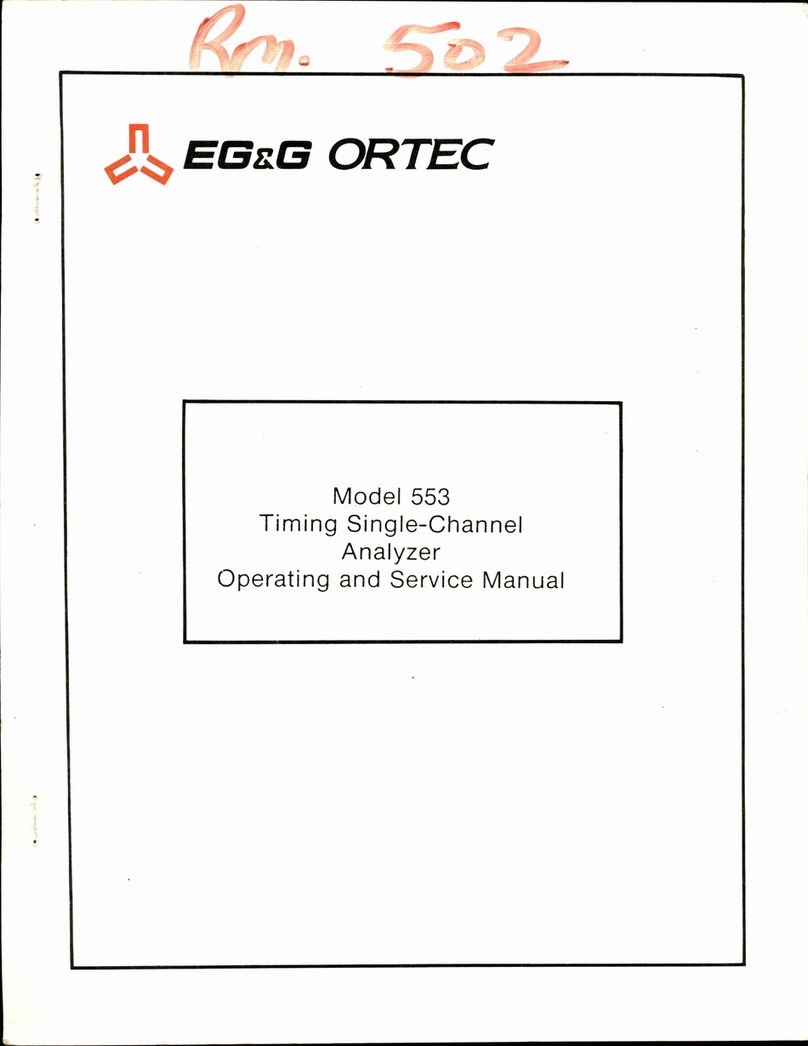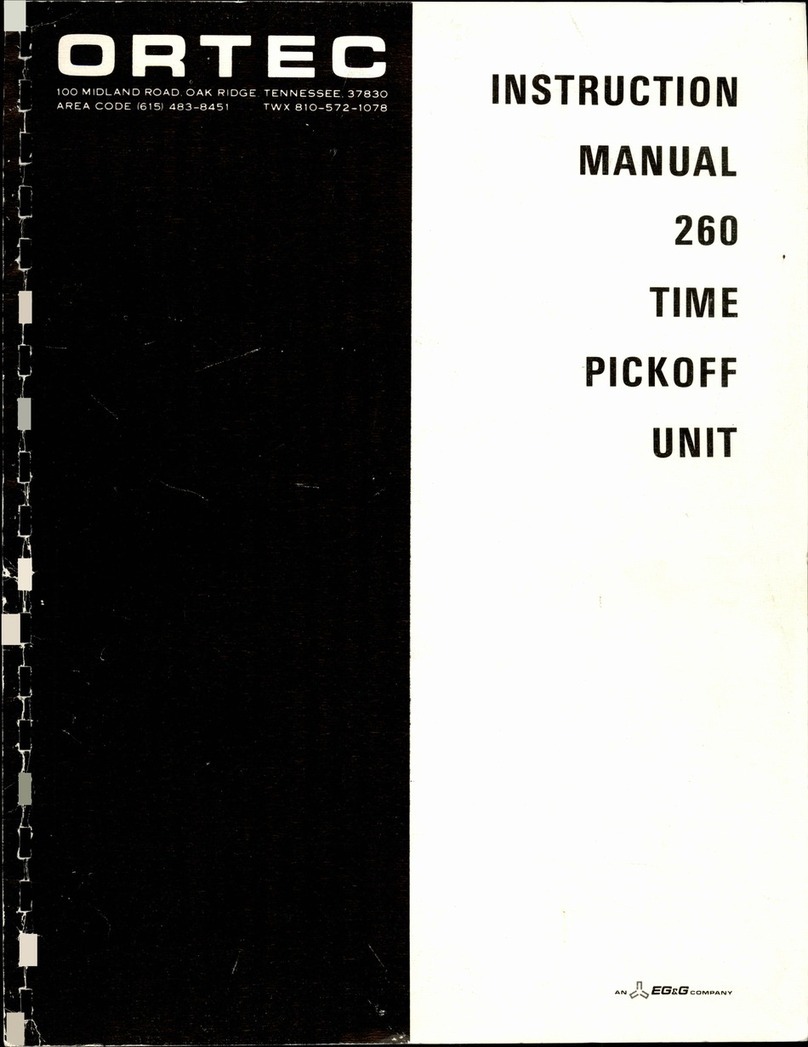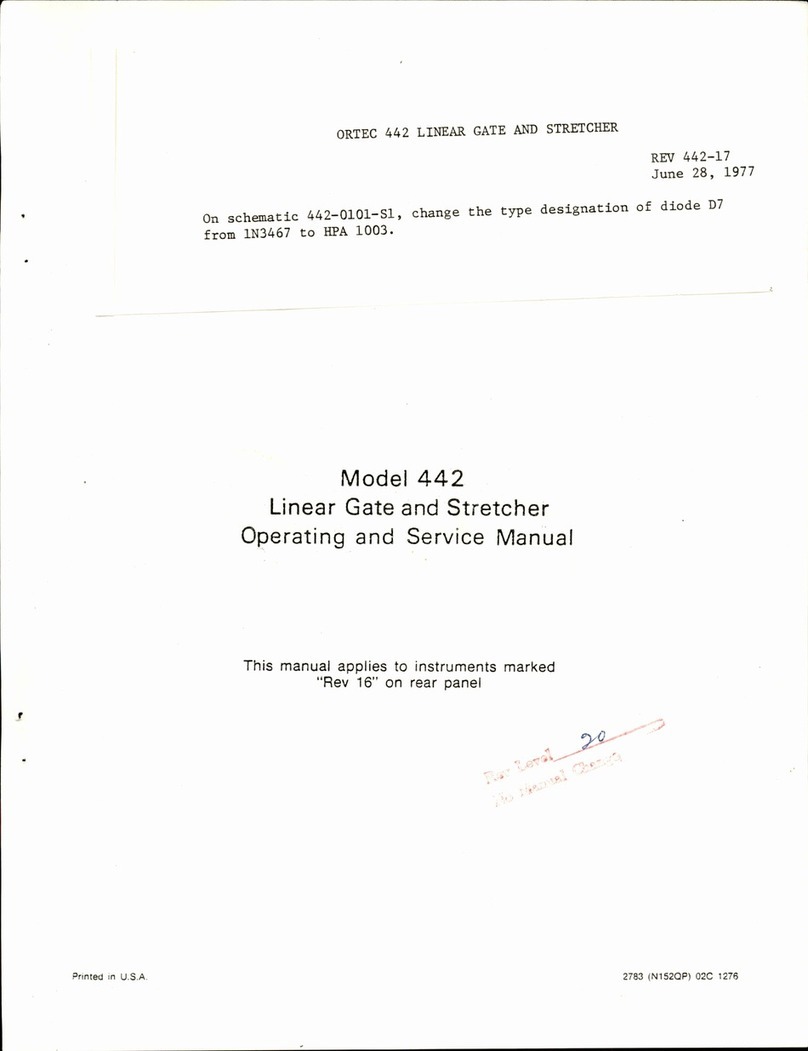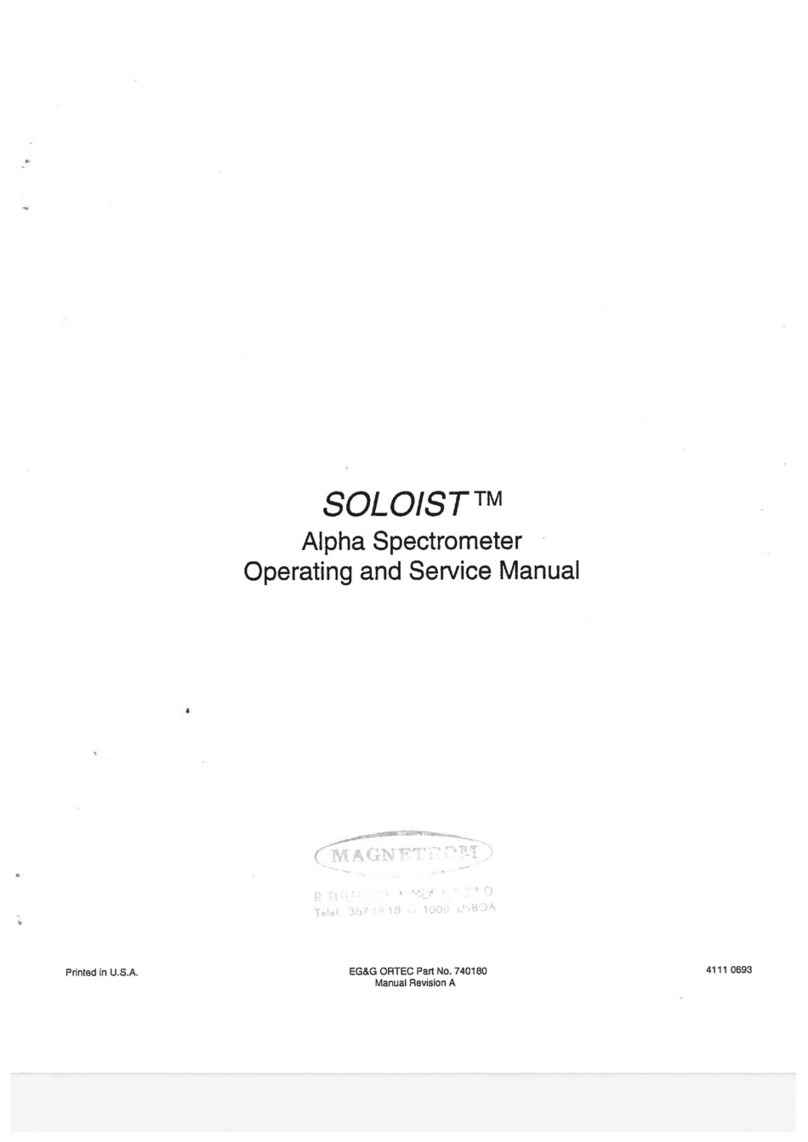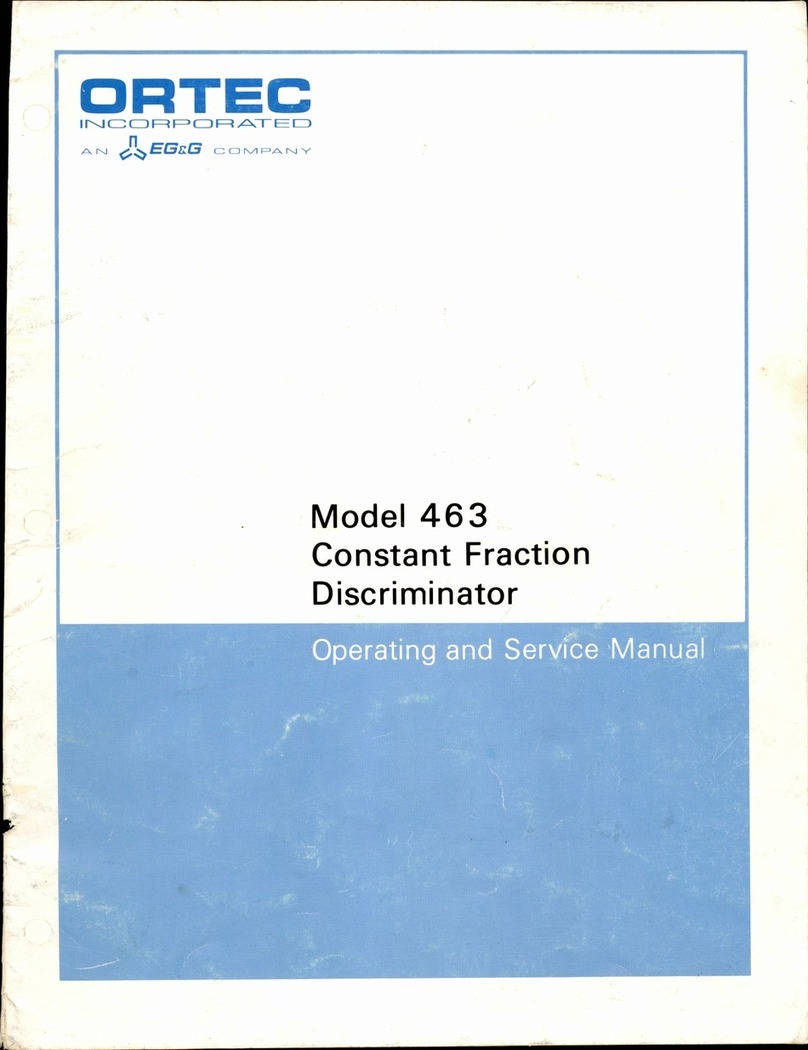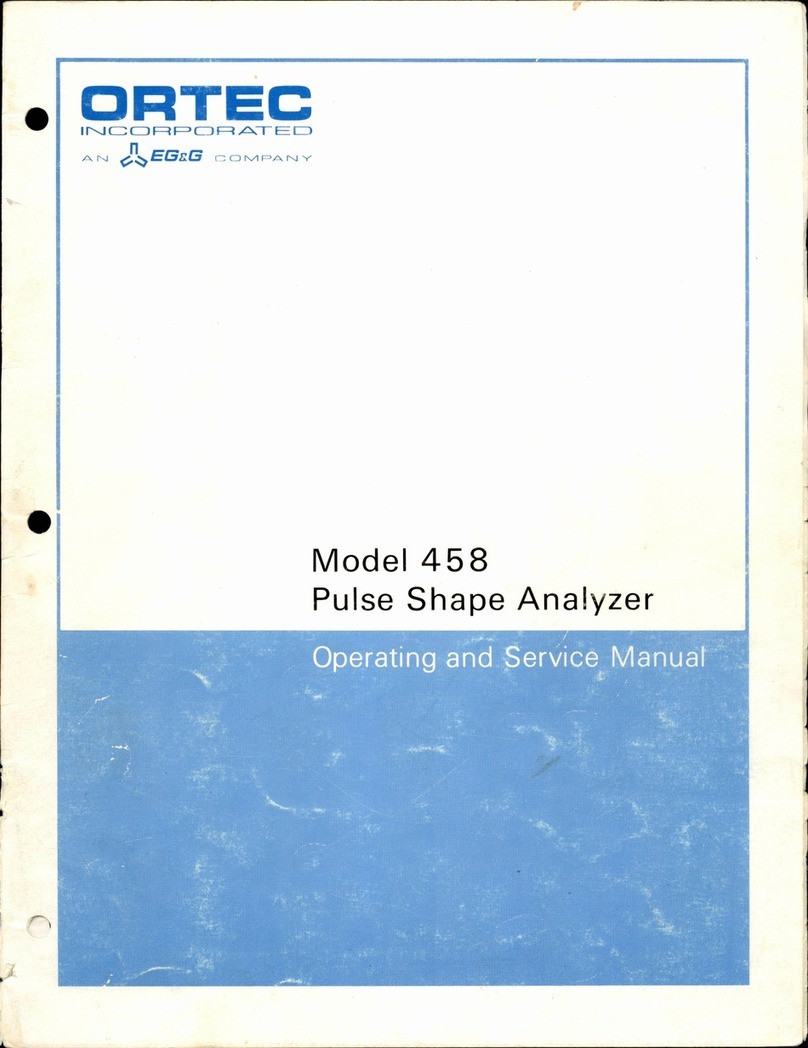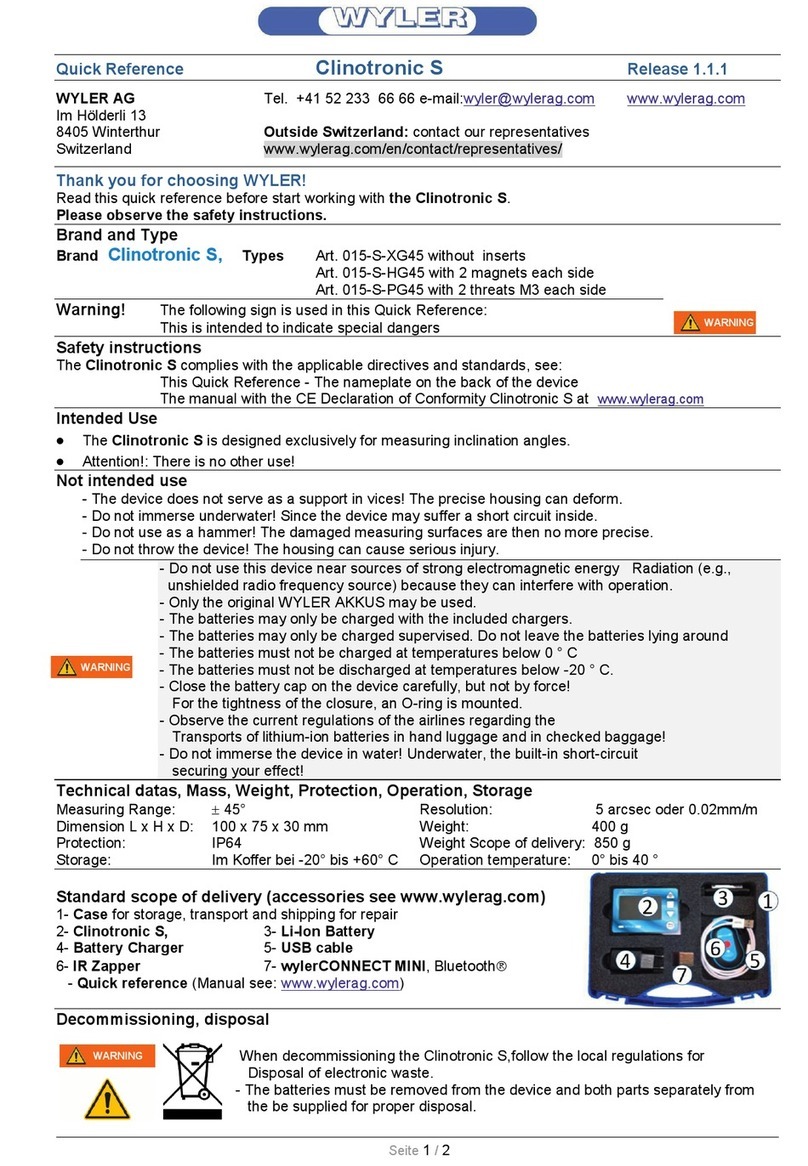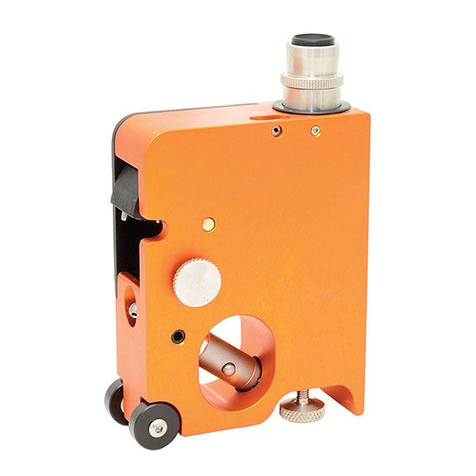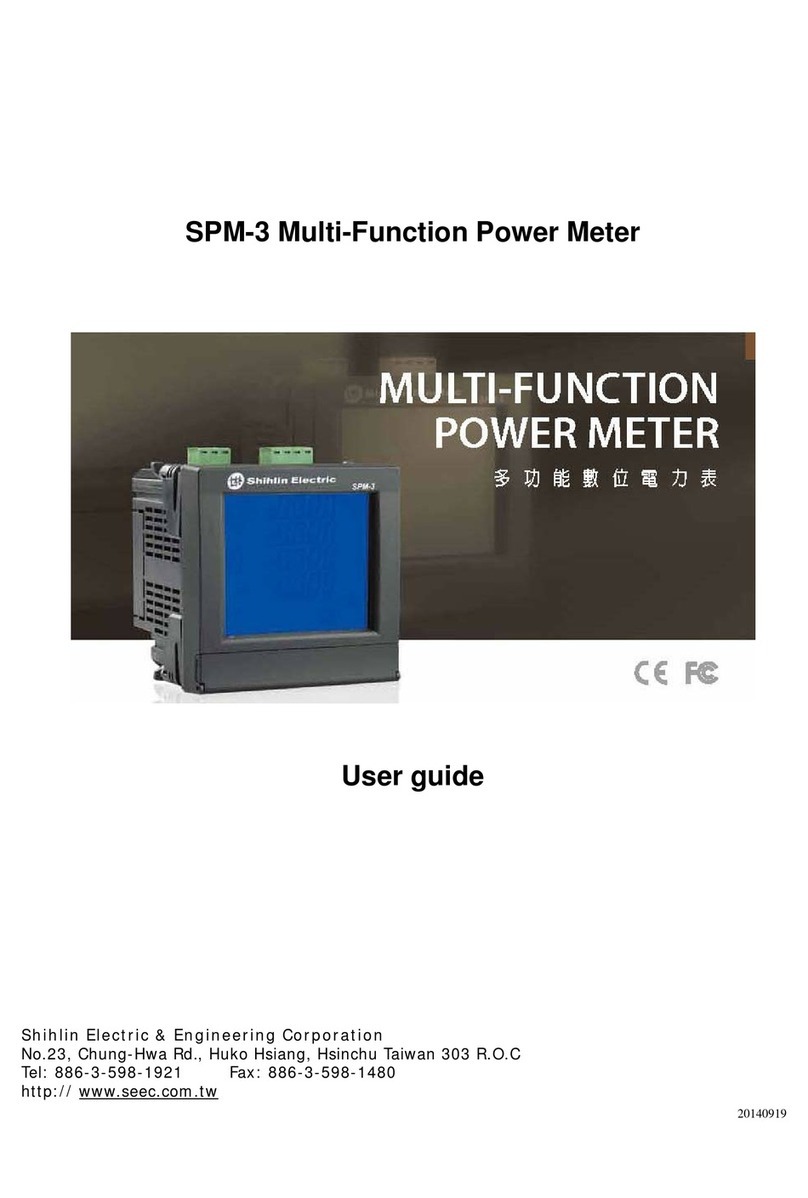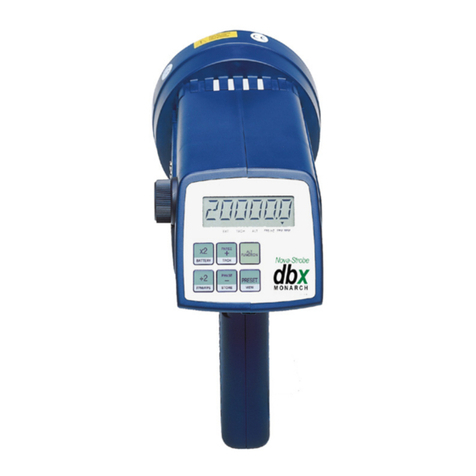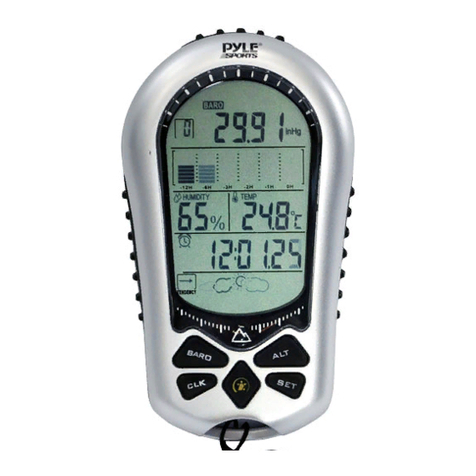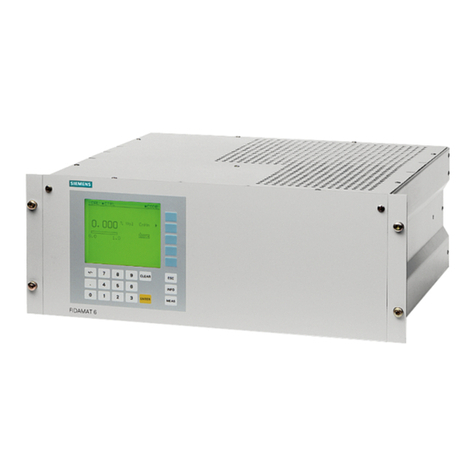EG&G ORTEC 455 Service manual

An~EiiD
c
a
i\/i
R»/\
rsj
V
Model
455
Constant
Fraction
Timing
Single
Channel
Analyzer

ORTEC
A55
CONSTANT
FRACTION
TIMING
SINGLE
CHANNEL
ANALYZER
Manual
Change
Sheet
ECN
455-9
January
30,
1973
On
schematic
455-0101-Sl,
change
the
designation
for
045
and
046
from
2N3646
to
MRS
6507
(Selected).

Model
455
Constant
Fraction
Timing
Single
Channel
Analyzer
Operating
and
Service
Manual
Printed
in
U
S.A.
Copyright
ORTEC
incorporated
1970
937
20
1072
(

STANDARD
WARRANTY
FOR
ORTEC
INSTRUMENTS
ORTEC
warrants
its
instruments
other
than
preampl
ifier
FET
input
transistors,
vacuum
tubes,
fuses,
and
batteries
to
be
free
from
defects
in
workmanship
and
materials
for
a
period
of
twelve
months
from
date
of
shipment
provided
that
the
equipment
has
been
used
in
a
proper
manner
and
not
subjected
to
abuse.
Repairs
or
replace
ment,
at
ORTEC
option,
wil
l
be
made
on
in-warranty
instruments,
without
charge,
at
the
ORTEC
factory.
Shipping
expense.wi
ll
be
to
the
account
of
the
customer
except
in
cases
of
defects
discovered
upon
initial
operation.
Warranties
of
vacuum
tubes
and
semiconductors
made
by
their
manufacturers
wil
l
be
extended
to
our
customers
only
to
the
extent
of
the
manufacturers'
l
iability
to
ORTEC.
Special
ly
selected
vacuum
tubes
or
semiconductors
cannot
be
warranted.
ORTEC
reserves
the
right
to
modify
the
design
of
its
products
without
incurring
responsibility
for
modification
of
previously
manufactured
units.
Since
in
stal
lation
conditions
are
beyond
our
control,
ORTEC
does
not
assume
any
risks
or
liabil
ities
associated
with
methods
of
instal
lation
or
with
instal
lation
results.
QUALITY
CONTROL
Before
being
approved
for
shipment,
each
ORTEC
in
strument
must
pass
a
stringent
set
of
qual
ity
control
tests
designed
to
expose
any
flaws
in
materials
or
workmanship.
Permanent
records
of
these
tests
are
maintained
for
use
in
warranty
repair
and
as
a
source
of
statistical
information
for
design
improvements.
ORTEC
must-be
informed
in
writing
of
the
nature
of
the
fault
of
the
instrument
being
returned
and
of
the
model
and
serial
numbers.
Failure
to
do
so
may
cause
unnecessary
delays
in
getting
the
unit
repaired.
Our
standard
procedure
requires
that
instruments
returned
for
repair
pass
the
same
qual
ity
control
tests
that
are
used
for
new-production
instruments.
Instruments
that
are
returned
should
be
packed
so
that
they
wi
l l
withstand
normal
transit
handl
ing
and
must
be
shipped
PREPAID
via
Air
Parcel
Post
or
United
Parcel
Service
to
the
nearest
ORTEC
repair
center.
Instru
ments
damaged
in
transit
due
to
inadequate
packing
will
be
repaired
at
the
sender's
expense,
and
it
wil
l
be
the
sender's
responsibility
to
make
claim
with
the
shipper.
Instruments
not
in
warranty
wi
l l
be
repaired
at
the
standard
charge
unless
they
have
been
grossly
misused
or
mishandled,
in
which
case
the
user
wil
l
be
notified
prior
to
the
repair
being
done.
A
quotation
wil
l
be
sent
with
the
notification.
DAMAGE
IN
TRANSIT
Shipments
should
be
examined
immediately
upon
receipt
for
evidence
of
external
or
concealed,
damage.
The
carrier
making
del
ivery
should
be
notified
immediately
of
any
such
damage,
since
the
carrier
is
normal
ly
liable
for
damage
in
shipment.
Packing
materials,
waybil
ls,
and
other
such
documentation
should
be
preserved
in
order
to
establish
claims.
After
such
notification
to
the
carrier,
please
notify
ORTEC
of
the
circumstances
so
that
we
may
assist
in
dam
age
claims
and
in
providing
replacement
equipment
if
necessary.

TABLE
OF
CONTENTS
Page
WARRANTY
ji
PHOTOGRAPHS
iv
1.
DESCRIPTION
1
2.
SPECIFICATIONS
2
3.
INSTALLATION
4
3.1
General
4
3.2
Connection
to
Power
4
3.3
Connection
to
a
Linear
Amplifier
4
3.4
Linear
Output
Signal
Connections
and
Terminating
Impedance
Considerations
4
4.
OPERATING
INSTRUCTIONS
5
4.1
Introduction
to
Fast
Timing
with
Linear
Signals
5
4.2
Typical
Operating
Conditions
5
4.3
Front-Panel
Control
Functions
5
4.4
Rear-Panel
Control
Functions
6
4.5
Connector
Data
6
5.
CIRCUIT
DESCRIPTION
7
5.1
Input
Circuit
7
5.2
Single
Channel
Analyzer
7
5.3
Reference
Levels
7
5.4
Internal
Timing
Signal
8
5.5
Single
Channel
Output
8
5.6
External
Strobe
Operation
8
6.
MAINTENANCE
INSTRUCTIONS
9
6.1
Testing
Performance
9
6.2
Calibration
Adjustments
9
6.3
Testing
the
455
Timing
Walk
10
6.4
Procedure
for
Adjusting
Walk
10
BLOCK
DIAGRAM
AND
SCHEMATIC
455-0101-B1
ORTEC
455
Block
Diagram
455-0101-S1
ORTEC
455
Schematic
LIST
OF
FIGURES
Page
Fig.
1.1.
Time
Resolution
as
a
Function
of
Dynamic
Range
1
Fig.
4.1.
Principle
of
Constant
Fraction
Timing
Signal
Derivation
5
Fig.
6.1.
Basic
Interconnections
for
Level
Calibrations
9
Fig.
6.2.
System
Interconnections
for
455
Walk
Test
10
Fig.
6.3.
Waveforms
for
Proper
Adjustment
10
Fig.
6.4.
Waveforms
for
Improper
Adjustment
10

ORTEC
MODEL
455
^
TIMING
SCA
NORM
70',
INT.
^
im.
1
FRACTION
UPPER
LEVEL
♦
LOWER
LEVEL
DELAY
INPUT
NEG.
OUT
POS.
OUT
'¥
'-OUTPUT-'
EXT
STROBE
I
EXT
BL-
EXT
|NTfc««t]
INPUT
BLR
DELAY
Hi
O.Huste
■I
DC

ORTEC
455
CONSTANT
FRACTION
TIMING
SCA
1.
DESCRIPTION
The
ORTEC
455
Constant
Fraction
Timing
Single
Channel
Analyzer
provides
both
pulse-height
and
timing
analysis
for
unipolar
and
bipolar
signals.
The
Constant
Fraction
Timing
technique
provides
unexcelled
timing
on
unipolar
pulses
and
a
unique
crossover
discriminator
shows
results
better
than
heretofore
possible
with
conventional
leading
edge
or
cross
over
discriminators.
Actual
timing
results
obtained
with
the
455
and
fast
plastic
scintillators
are
shown
in
Figure
1-1.
The
advantage
of
the
constant
fraction
timing
technique
is
readily
apparent.
With
SCA's
which
util
ize
leading
edge
timing,
the
risetime
of
the
input
pulses
causes
degradation
of
time
resolution
because
the
pulses
have
varying
amplitudes.
Constant
Fraction
timing
compensates
for
varying
amplitudes
and
essentially
eliminates
this
timing
shift,
giving
consistently
better
timing
results.
For
a
10%
fraction,
the
output
occurs
soon
after
the
peak
of
the
input
to
facil
itate
gating
and
accumulation
of
data
at
very
high
input
rates.
This
technique
also
minimizes
timing
shift
and
dead
time
when
used
with
sodium
iodide,
silicon,
and
germanium
detectors,
thereby
allowing
better
system
time
resolution
and
higher
counting
rates.
Timing
results
parallel
ing
those
in
Figure
1-1
are
also
possible
with
these
detectors.
The
Constant
Fraction
technique
makes
it
possible
to
real
ize
significant
improve
ments
in
most
applications
where
analysis
is
made
of
the
main
ampl
ifier
output.
It
allows
optimization
of
time
resolution
and
extension
of
dynamic
range
for
neutron-
gamma
discrimination.
The
455
can
accurately
analyze
the
output
pulses
of
any
shaping
amplifier
because
the
discriminator
levels
are
ex
tremely
sharp
and
stable.
A
front-panel
control
selects
four
SCA
modes:
integral,
100%,
20%,
and
normal.
These
modes
of
operation
are
described
in
the
specifications
that
follow.
With
all
of
its
versatility,
ease
of
operation
is
an
intrinsic
quality
of
the
455.
In
all
operating
modes
and
with
input
pulse
shaping
from
0.1
to
10
fxsec,
no
risetime
compensation
or
other
adjustments
are
necessary
for
proper
operation.
The
dc-coupled
input
of
the
455
makes
it
possible
to
take
full
advantage
of
the
baseline
restoration
of
the
main
amplifier.
For
amplifiers
with
ac-coupled
outputs,
two
ranges
of
dc
restoration
are
available.
These
features
ensure
stable
discrimination
levels
for
widely
varying
input
count
ing
rates,
and
hence
better
energy
discrimination.
The
continuously
adjustable
output
delay
(two
ranges
covering
0.1
to
11
iisec)
makes
it
possible
to
align
output
signals
which
have
actual
time
differences
without
a
need
for
additional
delay
devices
or
modules.
100
w
10
5
-
-
I
1
1 1 i 1 1 1
SOURCE
-60co
p.
M.
TUBES-58
5
AMPLIFIERS
-
MODEL
410's,DDL
DETECTOR
-
plastic
(Na
136)
Equivalent
Electron
Energy
=
'
>00
ke
45
5(
3i|:
0
ar
)
455
(10
%■
ra
:ti
or
i)
200406
10
DYNAMIC
RANGE,
fmax/fn
100
Figure
1-1.
Time
Resolution
as
a
Function
of
Dynamic
Range

2.
SPECIFICATIONS
PERFORMANCE
Time
shift
vs
pulse
height
(walk)
Constant
Fraction
Timing
Mode
Walk
(nsec)
System
A
System
B
<±1.5<±1.5
<±3.7
<±8
<±4.5
<±10
Dynamic
Range
10:1
50:1
100:1
System
A:
Using
ORTEC
410
Amplifier,
single
delay
line
mode,
integrate
<
0.1
jJsec
with delay
lines
of
0.2
to
2
iJsec.
System
8.
Using
ORTEC
450
or
451
Amplifier
unipolar
output
with
0.5-
IJsec
shaping
time
and
0.4
fraction.
Bi
Mode
Walk
(nsec)
<±
1
<
±
2.5
<
±
3
Dynamic
Range
10:1
50:1
100:1
Using
ORTEC
410
Amplifier,
double
delay
line
mode,
integrate
<0.1,
jJsec
with
delay
lines
of
0.2
to
2
jJsec.
Pulse
pair
resolution
0.5
jusec
plus
the
delay
time.
Nonlinearity
Lower
level
<
±
0.25%,
upper
level
<
±
0.25%.
(Nonlinearity
specifications
are
limited
by
the
10-turn
potentiometer.)
Temperature
stability
Upper
level
:
<
±
0.005%/°C
Lower
level:
<±
0.005%/°C
Delay:
<±0.01
%/°C
CONTROLS
LOWER
LEVEL
1
0-turn
control
sets
the
lower
level
from
100
mV
to
10
V
(1000
divisions
=
10
V).
UPPER
LEVEL
10-turn
control
sets
the
upper
level
from
100
mVto
10
V
(1000
divisions
=
10
V).
DELAY
RANGE
Rear-panel
switch
selects
range
of
0.1
to
1.1
or
1.0
to
11
tisec
delay.
DELAY
10-turn
control
for
continuously
adjusting
output
delay
over
selected
delay
range.
In
the
external
strobe
mode
the
delay
control
adjusts
the
automatic
reset
time
from
~
5
to
50
jjisec.
FRACTION
A
front
panel
switch
selects
the
fraction
of
0.1,
0.2,
0.3,
0.4,
and
0.5
for
Constant
Fraction
timing
with
unipolar
or
bipolar
inputs,
or
Bi
for
zero
crossing
timing
with
bipolar
inputs.
SCA
MODES
Front
panel
switch
selects
the
following
modes:
INTEGRAL
Timing
outputs
occur
for
all
signals
with
amplitudes
above
the
lower-level
discriminator
setting.
NORMAL
Timing
outputs
occur
for
signals
with
ampli
tudes
between
the
lower-level
and
upper-level
settings.
The
two
controls
are
independently
adjustable.
20%
WINDOW
Timing
outputs
occur
for
signals
with
amplitudes
between
the
lower
level
and
the
sum
of
the
lower-level
and
0.2X
upper
level.
The
span
(1000
divisions)
of
the
upper-level
control
(window)
is
2
V.
100%
WINDOW
Timing
outputs
occur
for
signals
with
amplitudes
between
the
lower
level
and
the
sum
of
the
lower
level
and
the
upper
level.
The
span
(1000
divisions)
of
the
upper-level
control
(window)
is
0
to
10
V.
RESTORER
A
3-position
rear-panel
switch
to
allow
input
dc-coupling,
or
a
high
or
low
basel
ine
restoration
rate.
EXT
STROBE/INT/EXT
BASELINE
A
rear-panel
switch
selects
internal
strobe
and
baseline,
external
baseline
reference,
or
external
strobe.
In
the
external
baseline
mode
the
lower
level
is
set
by
the
external
reference.
In
the
external
strobe
mode
the
timing
outputs
occur
in
coincidence
with
the
strobe
pulse.
WALK
ADJUST
Front
panel
screwdriver
adjustment
for
precise
setting
of
walk
compensation.
CONNECTORS
All
signal
connectors
are
BNC
connectors
(UG-1094/U).
INPUTS
Analog
Input
Amplitude
range
0
to
10
V
Pulse
width
range
0.2
to
20
/tsec
at
half
amplitude
Polarity
Positive
(unipolar)
or
positive
portion
leading
(bipolar)
Input
Impedance
1000
ohms
dc-coupled

External
Input
—
Strobe/Baseline
Input
impedance
Greater
than
1000
ohms
dc-coupled
Strobe
Input
+2
V
min,
+12
V
max,
75
nsec
min
width
Baseline
amplitude
0
to-10
V
OUTPUTS
Discriminator
Outputs
The
signal
occurs
promptly
when
the
input
exceeds
the
discriminator
threshold.
UL
Positive5
V,risetime<20
nsec,
width
0.5/isec,
Zq
=
<
10
ohms
(rear
panel).
LL
Positive
5
V,
risetime
<
20
nsec,
width
0.5
fxsec,
Zq
=
<
10
ohms
(rear
panel).
Timing
Outputs
In
the
Constant
Fraction
mode
the
timing
outputs
occur
when
the
input
pulse
has
fal
len
from
its
peak
by
the
selected
fraction
(plus
the
delay
time).
In
the
Bi
(bipolar)
mode
the
timing
outputs
occur
when
the
input
pulse
crosses
the
baseline
(plus
the
delay
time).
NEG
The
current
output
produces
0.7
V
minimum
into
50
ohms
with
risetime
<
5
nsec
and
width
<
20
nsec
(front
panel).
POS
Positive
5
V
risetime
less
than
20
nsec,
width
0.5
/isec,
Zq
=
<
10
ohms
(front
panel).
ORDERING
INFORMATION
Power
Required
+24
V
70
mA
+12
V
150
mA
-24
V
59
mA
-12
V
100
mA
Weight
(Shipping)
31b
6
oz
(1.5
kg)
Weight
(Net)
2
1b
7
oz
(1.1
kg)
Dimensions
Standard
single
width
module
per
TID-20893
(Rev.)

3.
INSTALLATION
3.1
General
The
ORTEC
455
is
designed
for
instal
lation
in
an
ORTEC
401A/402A
Bin
and
Power
Supply,
which
is
intended
for
rack
mounting.
Any
vacuum
tube
equipment
operated
in
the
same
rack
must
be
cooled
by
circulating
air
to
prevent
any
local
ized
heating
of
the
all-transistor
circuitry
used
throughout
the
455.
The
temperature
of
equipment
mounted
in
racks
can
easily
exceed
the
recommended
maximum
of
120°F
(50°C)
unless
precautions
are
taken.
3.2
Connection
to
Power
The
455
contains
no
internal
power
supply
and
so
must
obtain
power
from
a
Nuclear
Standard
Bin
and
Power
Supply
such
as
the
ORTEC
401A/402A.
Turn
off
the
Bin
power
supply
before
inserting
or
removing
modules.
The
ORTEC
400
Series
modules
are
designed
so
that
it
is
not
possible
to
overload
the
Bin
power
supply
with
a
full
complement
of
modules
in
the
Bin.
Since
this
may
not
be
true,
however,
when
the
Bin
contains
modules
other
than
those
of
ORTEC
design,
check
the
power
supply
voltages
after
inserting
modules.
The
401A/402A
has
test
points
on
the
power
supply
control
panel
to
monitor
the
dc
voltages.
3.3
Connection
to
a
Linear
Amplifier
The
input
to
the
455
is
a
front-panel
BNC
connector.
It
may
be
used
to
accept
outputs
from
all
linear
ampl
ifiers
capable
of
producing
10-V
unipolar
or
bipolar
(positive
lobe
leading)
signals
onto
a
1000-ohm
load.
The
input
operating
range
is
from
100
mV
to
10
V.
If
the
amplifier
output
is
attenuated
so
that
it
cannot
exceed
10
V,
the
455
may
be
used
with
vacuum
tube
amplifiers
which
are
capable
of
output
signals
to
100
V.
Simple
resisitve
attenuators
installed
in
the
vacuum
tube
amplifiers
will
make
them
compatible
with
related
transistor
equipment.
3.4
Linear
Output
Signal
Connections
and
Terminating
Impedance
Considerations
The
source
impedance
of
the
0-
to
10-V
standard
linear
outputs
of
most
ORTEC
400
Series
modules
is
approxi
mately
1
ohm.
Interconnection
of
linear
signals
is
thus
not
critical
since
the
input
impedance
of
the
455
is
high
and
is
not
important
in
determining
the
actual
signal
span.
0
to
10
V,
del
ivered
into
it.
It
is
permissible
to
parallel
several
loads
on
a
single
output
while
preserving
the
0-
to
10-V
signal
span.
Short
lengths
of
interconnecting
cable
(up
to
approxi
mately
4
ft)
need
not
be
terminated.
If,
however,
a
l
inear
signal
is
to
pass
through
more
than
approximately
4
ft
of
cable,
it
should
be
terminated
in
a
resistive
load
equal
to
the
cable
impedance.
Since
the
output
impedance
is
not
purely
resistive
and
is
sl
ightly
different
for
each
individual
module,
coaxial
cable
of
more
than
4
ft
not
terminated
in
the
characteristic
cable
impedance
wil
l
generally
cause
osci
l
lations.
These
oscil
lations
can
be
suppressed
for
any
length
of
cable
by
terminating
the
cable
properly,
either
in
series
at
the
sending
end
or
in
shunt
at
the
receiving
end
of
the
line.
To
terminate
a
cable
properly
at
the
receiving
end,
it
may
be
necessary
to
choose
an
additional
parallel
resistance
to
the
input
resistance
of
the
driven
circuit
to
make
the
combination
produce
the
desired
termination
resistance.
Series
terminating
the
cable
at
the
sending
end
may
be
preferable
when
receiving-end
terminating
is
not
possible
or
desirable.
Many
ORTEC
l
inear
instruments
include
an
alternate
output
connector
for
an
output
impedance
of
93
ohms,
and
this
connector
may
be
used
when
93-ohm
cable
is
used
for
the
interconnection:
the
impedance
match
wil
l
then
be
complete
without
any
compensation
at
the
high-impedance
receiving
end.
When
series
terminat
ing
at
the
sending
end,
full
signal
span
(ampl
itude)
is
obtained
at
the
receiving
end,
only
when
it
is
essentially
unloaded
or
is
loaded
with
an
impedance
many
times
that
of
the
cable.
Since
the
input
impedance
of
the
455
is
1000
ohms,
a
series
termination
at
the
sending
end
of
the
cable
wil
l
normally
provide
satisfactory
results.
BNC
tee
connectors
and
connectors
with
internal
resistive
terminators
are
available
from
a
number
of
manufacturers
in
nominal
values
of
50,
100,
and
1000
ohms
to
facil
itate
shunt
termination
at
the
receiving
end
of
a
cable.
ORTEC
stocks
in
l
imited
quantity
the
following
connector
ac
cessories
for
this
application:
ORTEC
C-27
100-ohm
Resistive
Terminator
ORTEC
C-28
50-ohm
Resistive
Terminator
ORTEC
C-29
BNC
Tee
Connector

4.
OPERATING
INSTRUCTIONS
4.1
Introduction
to
Fast
Timing
with
Linear
Signals
The
precise
determination
of
the
time
of
a
nuclear
event,
simultaneous
with
the
measurement
of
its
energy,
has
been
restricted
in
the
past
to
two
timing
techniques
—
zero
crossing
and
level
discrimination.
In
the
zero-crossing
method
the
timing
SCA
simply
detects
the
time
at
which
a
bipolar
linear
signal
crosses
the
baseline.
For
a
double-
delay-line
shaped
signal
the
zero-crossing
phase
point
con
tains
the
same
information
as
the
50%
charge
collection
time
on
the
leading
edge
of
the
signal.
For
some
signals
the
zero-crossing
point
provides
excellent
time
resolution.
There
are
two
rather
severe
limitations
to
the
zero-crossing
technique.
First,
the
ampl
itude
noise
of
a
bipolar
signal
is
normal
ly
worse
than
a
similarly
shaped
unipolar
signal.
Consequently,
the
edges
of
the
energy
window
set
by
the
SCA
are
not
as
precise
as
they
would
be
for
a
unipolar
signal
.
The
second
limitation
of
the
zero-crossing
technique
is
that
the
time
information
cannot
be
obtained
until
the
signal
crosses
the
basel
ine.
The
added
time
delay
before
getting
the
time
information
is
not
a
severe
limitation
in
DDL
applications,
but
for
simulated
Gaussian-shaped
signals
the
added
delay
may
be
several
microseconds.
A
simple
level
discriminator
is
used
to
obtain
time
infor
mation
by
the
second
technique.
The
usual
mode
of
operation
allows
the
level
discriminator
to
trigger
on
the
leading
edge
of
the
signal
and
to
then
reset
when
the
signal
falls
below
the
discriminator
level.
Either
of
these
trigger
points
can
be
used
for
the
timing
information.
If
the
leading-edge
trigger
point
is
used,
it
must
be
delayed
beyond
the
peak
of
the
input
signal
for
the
single-channel
ampli
tude
decision
to
be
made.
The
basic
l
imitation
of
this
system
is
that
it
introduces
a
time
walk
due
to
changing
signal
amplitudes,
and
the
magnitude
of
the
walk
is
usual
ly
equal
to
approximately
the
rise
time
of
the
signal.
For
different
types
of
signals
this
walk
wil
l
range
from
tens
of
nano
seconds
to
microseconds.
The
455
Constant
Fraction
Timing
Single
Channel
Analyzer
introduces
a
new
timing
technique
that
has
been
appl
ied
successful
ly
in
many
fast
timing
applications.
The
CFPHT
(Constant
Fraction
of
Pulse
Fleight
Trigger)
provides
a
degree
of
freedom
from
the
major
l
imitations
imposed
by
the
two
techniques
previously
used.
This
feature
can
be
understood
best
by
observing
the
basic
wave
shapes
in
Figure
4-1.
The
l
inear
signal
is
stretched
and
attenuated
by
an
amount
set
by
the
fraction
switch,
F.
The
timing
discriminator
is
triggered
when
the
signal
exceeds
the
lower-
level
discriminator.
The
timing
discriminator
is
then
reset
when
the
signal
becomes
less
than
the
stretched
attenuated
signal,
as
shown
in
Figure
4-1.
For
a
signal
with
a
different
amplitude
the
stretched
signal
remains
a
constant
fraction
of
the
signal
amplitude
and
the
reset
of
the
lower-level
discriminator
remains
time-invariant.
By
selecting
the
fraction
judiciously,
an
optimum
time
resolution
for
a
Linear
Amplifier
Signal
—
Fraction
f
Stretched
Signal
Lower
Level
Discriminator
Timing
Comparator
Signal
Figure
4-1.
Principle
of
Constant
Fraction
Timing
Signal
Derivation
given
signal
shape
can
be
obtained,
in
addition
to
the
systematic
walk
being
el
iminated.
Bipolar
inputs
can
be
accepted
but
are
not
required.
By
selecting
smaller
fractions,
the
timing
signal
is
derived
very
near
the
input
signal
peak
to
minimize
the
added
delay
before
the
signal
arrives
at
the
output.
4.2
Typical
Operating
Conditions
Each
application
of
the
455
involves
a
specific
detector-to-
amplifier
configuration
witli
unique
pulse
shape
character
istics.
Inspection
of
the
details
of
the
pulse
will
aid
in
selection
of
the
timing
fraction
that
will
provide
the
best
accuracy.
The
Constant
Fraction
is
selected
at
a
point
along
the
decay
of
the
input
pulse
and
measured
as
a
portion
of
the
drop
from
peak
amplitude
toward
the
baseline.
The
optimum
point
along
the
decay
is
one
with
maximum
slope
and
minimum
noise;
this
will
result
in
the
largest
slope-to-noise
ratio.
When
two
or
more
points
offer
about
equal
qual
ifications,
the
smaller
fraction
provides
the
earl
ier
timing
output.
Note
that
the
fraction
selected
refers
to
the
fraction
of
amplitude
decay
toward
the
baseline
as
measured
from
the
input
pulse
peak.
The
settings
are
from
10%
through
50%,
plus
Bipolar
which
is
equivalent
to
a
100%
fraction
selection.
The
resulting
stretched
signal
level
is
shown
to
be
greater
than
the
lower-level
discriminator
in
Figure
4-1,
but
this
condition
is
not
required;
in
fact,
the
smaller
ampl
itude
input
signals
which
are
just
large
enough
to
trigger
the
lower-level
discriminator
will
normally
provide
a
stretched
signal
level
below
the
lower
level
.
See
Sections
5.3
and
5.4
for
further
information.
4.3
Front-Panel
Control
Functions
Mode
Selector.
This
four-position
switch
selects
the
integral
mode
or
one
of
three
circuits
for
the
differential
mode
for
the
single-channel
analyzer.
For
the
integral
mode
the
lower-level
discriminator
or
an
external
baseline
will
determine
response,
and
no
upper-level
discriminator
is

involved.
For
NORM,
both
discriminators
are
effective
and
their
control
ranges
are
completely
independent;
the
Upper
Level
control
must
select
a
level
greater
than
the
Lower
Level
control
or
external
basel
ine
input,
or
no
output
can
be
generated.
For
the
20%
WIN
position,
the
Upper
Level
control
selects
the
amount
by
which
the
upper-level
discriminator
reference
exceeds
the
lower-
level
reference,
and
the
control
range
is
0
to
2
V.
For
the
100%
WIN
position
the
same
type
of
window
circuit
is
effective,
and
the
Upper
Level
control
range
is
increased
to
the
full
0-
to
10-V
dynamic
range.
FRACTION.
This
six-position
control
is
concentric
with
the
mode
selector.
It
permits
selection
of
10%,
20%,
30%,
40%,
or
50%
Fraction
for
timing
or
Bi,
which
is
the
con
ventional
zero-crossing
timing
mode.
See
Sections
4.2,
5.3,
and
5.4
for
suggestions
on
the
use
of
this
switch.
UPPER
LEVEL.
This
10-turn
precision
potentiometer
selects
the
upper-level
reference.
Its
range
is
0
to
10
V,
read
directly
by
the
1000
divisions
of
the
duo-dial.
When
the
455
operates
in
its
20%
Window
mode,
the
effective
range
of
the
Upper
Level
control
is
0
to
2
V.
LOWER
LEVEL.
This
10-turn
precision
potentiometer
selects
the
lower-level
reference,
except
when
a
rear-panel
switch
selects
External
Baseline.
Its
range
is
0.1
to
10
V,
read
directly
on
the
control.
DELAY.
This
10-turn
precision
potentiometer
adjusts
the
time
from
the
timing
comparator
signal
to
the
SCA
output
signals,
except
when
a
rear-panel
switch
is
set
at
External
Strobe.
The
delay
can
be
adjusted
from
0.1
through
11
us;
a
rear-panel
switch
selects
either
an
0.1-
to
1.1-/is
range
or
a
1.0-
to
11-^is
range
and
the
selected
delay
is
read
directly
on
the
control
of
the
potentiom
eter.
WALK
ADJ.
This
screwdriver
potentiometer
adjusts
for
minimum
time
walk,
as
a
fine
control
for
any
selected
fraction.
See
Section
6.7
for
further
information.
control
is
disconnected
and
the
lower-level
reference
must
be
furnished
by
a
0-
to
negative
10-V
bias
through
the
ad
jacent
BNC;
internal
strobe
must
be
used,
since
there
is
no
provision
for
an
external
strobe
input.
DELAY.
This
slide
switch
selects
either
of
the
two
effective
ranges
for
the
Delay
front-panel
control
.
The
ranges
are
0.1
through
1.1
/xs
and
1.0
through
11
us.
BLR.
This
3-position
slide
switch
selects
the
input
circuit
appropriate
to
each
specific
application.
The
DC
position
is
a
dc-coupled
input
and
may
be
used
when
there
is
no
basel
ine
offset
furnished
from
the
input
pulse
source.
LO
and
HI
positions
refer
to
the
average
input
pulse
rate;
the
LO
position
selects
a
passive
restoration
circuit,
while
the
HI
position
selects
an
active
baseline
restorer.
4.5
Connector
Data
INPUT.
A
BNC
connector
accepts
the
analog
input
signals
into
an
input
impedance
of
1000
ohms.
The
input
circuit
wil
l
be
either
dc-
or
ac-coupled,
depending
upon
the
selection
of
the
rear-panel
BLR
switch.
Either
positive
unipolar
pulses
or
bipolar
pulses
with
positive
leading
portion
may
be
furnished
within
the
0-
to
-HO-V
linear
range.
NEG.
OUT.
A
standard
ORTEC
(and
NIM)
fast
negative
logic
signal
is
available
through
this
BNC
connector
for
optimum
timing
resolution.
This
is
a
current
output
pulse
that
produces
0.7
V
minimum
into
50
ohms.
PCS.
OUT.
A
standard
ORTEC
(and
NIM)
slow
positive
logic
signal
is
available
through
this
BNC
connector
for
appl
ications
such
as
analyzer
gating
and
coincidence
timing.
UL.
A
standard
ORTEC
(and
NIM)
slow
positive
logic
si^al
is
furnished
through
this
BNC
connector
each
time
the
upper-level
discriminator
is
triggered,
without
regard
to
the
internal
use
of
the
upper-level
response.
4.4
Rear-Panel
Control
Functions
EXT
STROBE/INT/EXT
BL.
This
3-position
slide
switch
permits
the
adjacent
BNC
connector
to
be
used
for
either
of
two
externally
control
led
functions.
When
it
is
set
at
INT,
neither
of
the
external
functions
will
be
effective.
When
it
is
set
at
EXT
STROBE,
the
SCA
timing
outputs
occur
in
coincidence
with
an
external
strobe
input
pulse
furnished
through
the
BNC,
and
this
must
occur
within
less
than
50
/xs
after
the
lower-level
discriminator
is
triggered;
the
lower-level
reference
is
set
by
the
front-panel
Lower
Level
control
during
the
external
strobe
mode.
When
the
switch
is
set
at
EXT
BL,
the
front-panel
Lower
Level
LL.
A
standard
ORTEC
(and
NIM)
slow
positive
logic
signal
is
furnished
through
this
BNC
connector
each
time
the
lower-level
discriminator
is
triggered,
without
regard
to
the
internal
use
of
the
lower-level
response.
EXT
INPUT.
This
BNC
connector
accepts
either
external
strobe
pulses
or
an
external
basel
ine
bias
level,
depending
upon
the
selection
of
the
adjacent
3-position
slide
switch.
Test
Points.
Oscilloscope
test
points
for
monitoring
the
input
and
the
two
single-channel
outputs
on
the
front
panel
are
available
at
each
connector.
Each
test
point
is
connected
to
its
respective
connector
through
a
470-ohm
series
resistor.

5.
CIRCUIT
DESCRIPTION
5.1
Input
Circuit
The
input
signal
is
presented
to
a
dc-restorer
circuit,
or
is
de-coupled,
directly
into
a
unity
gain
ampl
ifier,
Q5
to
Q9.
A
rear-panel
switch
selects
either
HI
or
LO
dc-restoration
rate
or
dc-coupling.
Input
capacitor
C1
is
simply
bypassed
for
dc-coupling.
For
the
LO
restoration
rate,
01
and
02
form
a
Robinson
type
of
restorer
circuit.
For
the
HI
restoration
rate,
03
and
04
operate
as
a
high-gain
dif
ferential
ampl
ifier
to
feed
back
a
voltage
to
the
emitter
of
02
that
is
inversely
proportional
to
the
dc
offset
voltage
at
01.
Thus,
in
the
HI
rate
circuit,
restoration
of
the
voltage
to
zero
is
achieved
by
an
active
closed-loop
feedback
amplifier.
Following
the
restorer,
the
signal
is
attenuated
for
half
of
its
input
value,
using
resistors
R9
and
RIO.
It
is
then
buf
fered
by
the
unity
gain
ampl
ifier,
05
—
09,
and
furnished
to
four
internal
circuits.
The
amplifier
is
dc-coupled
with
a
very
low
output
impedance
to
drive
all
three
comparators,
10
5
through
10
7,
with
no
appreciable
loading
effects
due
to
the
comparator
base
currents.
The
signal
at
the
unity
gain
amplifier
output
has
half
of
the
input
ampl
itude
for
its
positive
polarity;
any
negative
polarity
included
in
the
input
is
clipped
two
diode
junctions
(approximately
-1.4
V)
below
zero.
The
quiescent
voltage
at
the
ampl
ifier
output
is
zero
volts.
The
amplifier
output
signal
is
presented
to
three
voltage
comparators,
IC
5,
IC
6,
and
IC
7,
and
to
a
pulse
stretcher,
Q17
through
Q21.
Comparators
IC
5
and
IC
6
form
a
con
ventional
single-channel
pulse-height
analyzer.
Comparator
IC
7
and
the
stretcher
perform
a
unique
timing
analysis.
5.2
Single
Channel
Analyzer
Lower
Level
comparator
IC
6
accepts
a
bias
level
B
from
IC
88
and
the
unity
gain
amplifier
output.
In
the
quiescent
state,
IC
6
output
is
~
-1-1.5
V.
When
the
signal
level
exceeds
the
reference
level
B,
the
output
switches
rapidly
to
0.5
V
and
remains
until
the
signal
level
drops
below
the
reference
level
again.
The
comparator
is
a
type
/iA710
with
fast
switching
speed,
and
responds
to
signals
as
short
as
200
ns.
The
negative
transition
of
the
output
triggers
two
monostables;
one
forms
a
Lower
Level
output
pulse
through
the
rear-panel
LL
connector
and
the
other
is
a
temporary
memory
to
hold
the
response
until
an
output
trigger
occurs.
Upper
Level
comparator
IC
5
accepts
a
bias
level
A
from
IC
8A
and
the
output
from
the
unity
gain
ampl
ifier.
Its
operation
is
identical
to
that
of
IC
6,
discussed
above,
and
this
comparator
also
triggers
two
monostables;
one
forms
an
Upper
Level
output
pulse
and
the
other
is
a
temporary
memory.
The
Lower
Level
output
pulse
is
a
NIM
standard
slow
positive
pulse
formed
when
IC
4B
and
Q32
and
Q33,
a
monostable,
receives
the
negative
transistion
of
the
IC
6
comparator
output.
The
output
pulse
duration
is
0.5
/xs
and
its
ampl
itude
is
-(-5
V
approximately.
The
pulse
occurs
on
the
leading
edge
of
the
input
pulse
when
the
input
exceeds
the
Lower
Level
bias
and
is
available
through
the
rear-panel
LL
connector.
The
Upper
Level
output
pulse
is
identical
to
the
Lower
Level
output
discussed
above
and
is
generated
by
IC
4A,
Q40,
and
Q41.
It
occurs
on
the
leading
edge
of
the
input
pulse
when
the
input
exceeds
the
Upper
Level
bias
and
is
available
through
the
rear-panel
UL
connector.
The
temporary
memory
for
the
Lower
Level
comparator
is
IC
2,
sections
A,
B,
C,
and
D.
It
is
a
monostable
with
a
duration
of
50
us
but
is
normal
ly
reset
prior
to
this
time,
just
after
the
pulse-height
decision
is
made.
Its
output
goes
from
-i-1.5
V
to
-0.5
V
and
is
furnished
as
one
of
two
inputs
to
IC
1D.
The
temporary
memory
for
the
Upper
Level
comparator
is
IC
1,
sections
A,
B,
and
C.
It
also
has
a
dura
tion
of
50
/xs,
subject
to
prior
reset.
The
output
from
this
memory,
furnished
as
the
second
input
to
IC
ID,
goes
from
-0.5
V
to
+^
.5
V
when
it
is
triggered.
When
either
input
(or
both)
to
OR
gate
IC
1D
is
at
t-l
.5
V,
it
will
drive
067
into
saturation,
thus
preventing
the
timing
signal
from
appearing
at
the
collector
of
038.
A
single-
channel
output
pulse
will
be
generated
by
a
delay
mono-
stable,
045
to
049,
when
it
recovers
after
being
triggered
by
a
pulse
through
038;
but
067
must
be
cut
off
to
permit
the
trigger
pulse
to
reach
the
monostable.
Only
when
both
IC
ID
gate
inputs
are
at
the
low
state
(~
0
V)
wil
l
the
trigger
pulse
be
effective.
This
condition
is
equivalent
to
the
logic
that
permits
the
generation
of
a
single-channel
output
pulse
and
al
lows
the
timing
circuit
to
determine
when
the
pulse
will
be
generated.
The
sig
nal
into
IC
ID
from
IC
1A,
B,
and
C
is
low
when
the
Upper
Level
discriminator
has
not
been
triggered
or
when
the
front-panel
selector
switch
is
set
for
Integral
mode
operation.
The
signal
into
IC
ID
from
IC
2
is
low
only
after
the
Lower
Level
discriminator
has
been
trig
gered.
Thus,
for
the
Integral
mode
of
operation,
a
single-
channel
output
will
be
generated
for
each
pulse
that
has
an
ampl
itude
greater
than
the
setting
of
the
Lower
Level
bias
B.
For
Normal
and
Window
modes
a
single-channel
output
wil
l
be
generated
if
the
input
pulse
amplitude
exceeds
the
B
reference
level
but
does
not
exceed
the
A
reference
level
(Upper
Level).
For
each
such
input
pulse
with
too
large
an
ampl
itude,
a
permissive
condition
will
exist
for
a
short
time
interval
during
the
input
pulse
rise
time,
but
the
out
put
trigger
will
not
occur
until
a
selected
time
after
the
input
pulse
peak;
so
the
false
indication
wil
l
not
be
sampled.
5.3
Reference
Levels
A
3-position
rear-panel
switch
selects
External
Strobe
with
internal
baseline
control.
External
Basel
ine
control
with
internal
strobe,
or
Internal
strobe
and
basel
ine.
The
BL
switch
position
selects
external
basel
ine
control,
which
re
moves
the
Lower
Level
control
from
the
455
internal
cir-

cuit
and
allows
a
0-
to
-10-V
signal
to
be
accepted
through
the
rear-panel
BNC
connector
for
use
as
the
B
reference
level
after
attenuation
by
a
factor
of
2.
For
either
of
the
other
two
switch
positions,
reference
level
B
is
determined
by
the
setting
of
the
front-panel
Lower
Level
control.
The
Lower
and
Upper
Level
channels
have
a
common
-5-V
reference
level,
regulated
by
D8.
Lower
Level
adjustment
R39
selects
a
level
between
0
and
-5
V
and
appl
ies
it
to
unity
gain
amplifier
Q56,Q59,Q60,Q61,
and
Q65.
The
unity
gain
ampl
ifier
hasa
high
input
impedance
for
minimum
current
drain
from
the
D8
reference
source
and
for
buffering
the
potentiometer
from
all
other
circuitry.
Upper
Level
adjustment
R29
independently
selects
a
level
between
0
and
-5
V
and
appl
ies
it
to
its
unity
gain
amplifier,
Q54
through
Q57
and
Q67.
Fol
lowing
the
unity
gain
amplifiers
is
the
dual
operational
amplifier
IC
8.
The
unity
gain
ampl
ifier
for
the
Lower
Level
furnishes
its
output
directly
to
IC
8B
to
be
inverted
for
a
0-
to
-1-5-V
reference
level
B.
The
input
to
IC
8A
is
determined
by
the
setting
of
the
front-panel
mode
selector
and
either
is
the
independent
Upper
Level
selection
or
is
the
sum
of
the
Lower
Level
and
the
Upper
Level
adjust
ments.
Its
output
is
reference
level
A,
applied
to
the
Upper
Level
comparator.
For
the
Integral
mode
the
Upper
Level
reference
A
is
full-
range
0
to
-1-5
V.
The
Upper
Level
comparator
triggers
its
monostables
in
the
normal
manner
to
provide
an
Upper
Level
output
signal
if
the
input
amplitude
exceeds
reference
level
A;
the
mode
switch
furnishes
ground
potential
to
OR
gate
IC
1D_
to
overcome
and
defeat
any
inhibit
that
is
generated
in
IC
1A,
B,
and
C.
For
the
Normal
mode
the
same
circuit
is
used
for
the
input
to
the
Upper
Level
comparator,
and
the
mode
switch
now
opens
the
ground
circuit
and
permits
the
response
in
the
Upper
Level
to
inhibit
a
single-channel
output
pulse.
For
the
20%
Window
mode,
reference
B
is
determined
by
the
setting
of
the
Lower
Level
adjustment
or
by
the
Ex
ternal
Baseline
input
and
is
also
appl
ied
through
R61
into
IC
8A.
The
signal
from
the
Upper
Level
adjustment
is
applied
through
R62
and
is
summed
with
the
signal
from
the
Lower
Level
adjustment
at
the
input
to
IC
8A.
Thus
the
reference
level
A
is
based
on
both
adjustment
levels,
and
the
range
of
the
Upper
Level
(Window)
above
the
Lower
Level
is
20%
of
the
normal
full
range.
In
the
100%
Window
mode
a
similar
circuit
connects
the
Upper
Level
selection
into
the
summed
junction
through
R60;
so
it
is
not
attenuated
and
the
range
is
100%
of
the
normal
full
range.
5.4
Internal
Timing
Signal
A
timing
signal
is
derived
with
two
basic
circuits,
pulse
stretcher
Q17
through
Q29
and
fast
comparator
IC
7.
The
pulse
stretcher
accepts
an
attenuated
signal
from
the
unity
gain
amplifier,
Q5
through
Q9.
Attenuation
is
selected
by
the
setting
of
the
FRACTION
switch
on
the
front
panel.
The
attenuated
positive
portion
of
the
signal
passes
through
the
stretcher
amplifier,
017
to
021,
which
charges
C49
through
D16
until
the
input
signal
peak
occurs.
This
charge
is
maintained
by
the
023
stretcher
gate,
opened
at
the
proper
time.
The
timing
reference
for
comparator
IC
7
is
obtained
from
the
charge
on
C49
through
unity
gain
ampl
ifier
024
through
029.
During
quiescent
intervals
the
B
reference
level
is
applied
as
the
timing
reference
input
through
015
and
016.
When
the
input
pulse
ampl
itude
exceeds
the
B
reference
level,
comparator
IC
7
switches
from
high
to
low.
This
coincides
with
the
switching
time
of
IC
2,
which
switches
Oil
off
and
012
on.
From
this
time
until
internal
reset,
the
timing
reference
level
is
the
stretched
output
through
013
and
014
and
the
input
signal
wil
l
logically
exceed
the
timing
reference
level
until
it
reaches
a
point
on
the
decay
of
the
input
signal
where
there
is
a
crossover.
At
the
time
that
the
input
signal
crosses
through
the
timing
reference
level
IC
7
resets
for
a
high
output,
this
transition
being
the
timing
signal.
IC
7
remains
in
its
high
state
only
momentarily
if
the
input
signal
exceeds
the
B
reference
level
.
After
the
signal
decreases
below
the
B
reference
level,
IC
7
again
switches
to
high
and
this
closes
the
stretcher
gate
to
discharge
C49.
The
timing
signal
from
IC
7
is
differentiated
and
inverted
by
C56,
034,
and
044
and
is
routed
to
parallel
gate
038
and
067.
If
the
input
signal
has
met
the
single-channel
logic
conditions,
the
gate
wil
l
be
opened
and
the
timing
signal
triggers
the
delay
generator,
045
and
046.
5.5
Single
Channel
Output
The
delay
generator,
045
and
046,
is
a
monostable
with
an
adjusted
recovery
period.
The
delay
interval
is
selected
within
the
range
of
0.1
through
11
us
with
front-panel
controls.
The
delay
generator
output
triggers
a
current
switch,
Q50
to
053,
to
produce
the
NIM
standard
Fast
Negative
output,
and
it
also
triggers
a
0.5-ns
shaping
monostable,
IC
4C,
042,
and
043
for
the
NIM
standard
Slow
Positive
output.
5.6
External
Strobe
Operation
The
External
Strobe
mode
can
be
selected
by
setting
the
rear-panel
switch
at
its
STROBE
position.
A
NIM
standard
Slow
Positive
signal
through
the
rear-panel
BNC
connector
wil
l
then
determine
when
theoutput
pulse
will
be
generated.
For
this
mode
of
operation
all
of
the
internal
logic
operates
in
the
same
manner
as
for
internal
strobe,
except
that
the
delay
time
of
monostable
045
and
Q46
is
extended
and
the
external
strobe
will
reset
it
prior
to
its
natural
recovery
to
generate
the
output.
The
delay
circuit
recovery
is
extended
to
~
50/.ts
by
setting
the
front-panel
controls
for
maximum
delay,
11
/ts.

6.
MAINTENANCE
INSTRUCTIONS
6.1
Testing
Performance
6.1.1
Introduction.
The
following
material
will
aid
in
installing
and
checking
out
the
455.
It
consists
of
in
formation
on
front
panel
controls,
waveforms,
test
points,
and
output
connectors.
6.1.2
Test
Equipment.
The
following,
or
equivalent,
test
equipment
is
needed:
1.
ORTEC
419
Pulse
Generator
2.
Tektronix
454
Series
Oscilloscope
3.
100-ohm
BNC
terminators
4.
ORTEC
410
or
450
Amplifier
5.
Schematics
and
Block
Diagrams
for
the
455
Timing
Single
Channel
Analyzer
6.1.3
Preliminary
Procedures.
1.
Visually
check
module
for
possible
damage
due
to
shipment.
2.
Plug
module
into
Nuclear
Standard
Bin
and
Power
Supply,
e.g.,
ORTEC
401A/402A,
and
check
for
proper
mechanical
alignment.
3.
Connect
ac
power
to
Bin.
4.
Switch
on
ac
power
and
check
the
dc
power
voltages
at
the
test
points
on
the
402A
Power
Supply
control
panel.
6.1.4
Testing
the
Single
Channel
Function
1.
Connect
the
direct
output
of
the
pulse
generator
to
the
scope
trigger.
Connect
the
attenuated
output
of
the
pulse
generator
to
the
input
of
the
Ampl
ifier.
Place
al
l
attenuator
switches
on
the
pulse
generator
to
the
OUT
position
except
one
switch,
which
should
be
a
XI0
switch.
Adjust
the
pulse
generator
output
and/or
amplifier
gain
control
to
achieve
an
amplifier
output
pulse
height
of
approximately
10
V.
2.
Connect
the
ampl
ifier
output
to
the
455
input.
Set
the
455
mode
selector
at
INT.
Set
the
rear-panel
3-position
slide
switch
at
INT
and
the
BLR
switch
at
DC.
Adjust
the
Lower
Level
dial
to
500/1000
divisions.
There
should
now
be
an
output
from
both
the
NEC
and
POS
OUT
connectors
on
the
455.
Turn
the
Lower
Level
control
to
read
1000,
then
adjust
the
pulse
height
from
the
amplifier
so
the
455
half-triggers.
Now
set
the
X2
attenuator
switch
on
the
pulse
generator
to
reduce
the
pulse
ampl
itude
to
half
of
the
pre
vious
level.
Reduce
the
455
Lower
Level
control;
the
half-
trigger
point
should
occur
at
~
500
dial
divisions.
Next,
reduce
the
Lower
Level
control
to
400
dial
divisions
and
set
the
mode
selector
at
100%
WIN.
Starting
with
the
Upper
Level
control
well
above
100
dial
divisions,
reduce
the
Upper
Level
toward
zero;
a
half-trigger
point
should
be
noted
at
about
100
dial
divisions.
Now
switch
the
mode
selector
for
a
20%
WIN
setting,
and
advance
the
Upper
Level
control
until
the
455
again
half-triggers,
which
should
occur
with
the
control
at
about
500
dial
divisions.
These
steps
will
prove
that
the
455
is
operating
correctly
as
a
single-channel
analyzer
in
all
three
basic
modes.
The
steps
may
be
repeated
for
other
levels
of
pulse
height
and
for
other
logical
combinations
of
Lower
Level
and
Upper
Level
adjustments
and
for
the
NORM
mode
selection.
6.2
Calibration
Adjustments
6.2.1
Input
Offset
Adjustment.
Potentiometer
R12
is
used
to
zero
the
dc
offset
at
the
amplifier
input.
R12
is
the
4th
potentiometer
from
the
front
of
the
printed
circuit
board.
Use
TP4
to
observe
the
dc
offset.
TP4
is
the
2nd
test
point
from
the
front
panel
near
the
top
of
the
printed
circuit
board.
With
no
input
signal
applied,
set
R12
for
zero
+2
mV
at
TP4.
6.2.2
Lower
Level
Zero
Adjustment.
Potentiometer
R52
adjusts
the
Lower
Level
Zero,
and
is
the
2nd
from
the
front
of
the
printed
circuit
board.
Use
the
following
steps:
1.
Connect
the
system
shown
in
Figure
6-1.
2.
Set
the
455
for
BLR
LO,
for
the
INT
mode,
and
for
a
Lower
Level
setting
of
1000
dial
divisions.
Adjust
the
pulser
for
half-triggering,
which
should
occur
at
about
10
V.
3.
Reduce
the
Lower
Level
control
to
10
dial
divisions
and
attenuate
the
pulser
output
by
100;
this
should
provide
100
mV
to
the
455
input.
Adjust
R52
for
half-triggering
of
the
Lower
Level
output.
4.
Repeat
steps
2
and
3
to
overcome
any
interaction
of
controls.
6.2.3
Upper
Level
Zero
Adjust.
Zero
adjustment
for
the
Upper
Level
controls
uses
R57,
which
is
the
3rd
potenti
ometer
from
the
front
panel
on
the
printed
circuit
board.
Use
the
four
steps
of
Section
6.2.2
with
the
455
set
for
NORM
mode.
Observe
the
output
through
the
UL
connector
on
the
rear
panel.
ORTEC ORTEC ORTEC
450
455
419
CONSTANT
0
r
ny
FRACTION
PULSER
LINEAR
TIMING
AMPLIFIER
SCA
LL
Output
OSCILLO
Figure
6-1.
Basic
Interconnections
for
Level
Calibrations
©

10
6.2.4
Timing
Discriminator
timing
discriminator
should
sl
ightly
less
on
the
input
trigger.
After
the
Lower
discussed
in
Section
6.2.2,
ovoltmeter
to
pin
2
of
IC
on
the
printed
circuit
board,
Sensitivity
Adjustments.
The
trigger
at
an
ampl
itude
only
signal
than
the
Lower
Level
Level
has
been
adjusted
as
connect
a
sensitive
dc
milli-
7.
Adjust
R100,
at
the
front
for
20
to
30
mV
on
the
meter.
6.3
Testing
the
455
Timing
Walk
A
system
for
checking
the
walk
of
the
455
SCA
output
is
shown
in
Figure
6-2.
Adjust
the
pulsar's
Normalize
control
for
10V
at
the
455
input.
Set
the
Tektronix
454
Oscillo
scope
B
Sweep
Mode
to
B
Starts
After
Delay
Time;
set
the
Horizontal
Display
switch
to
B
(Delayed
Sweep);
set
the
Delay
Time
to
0.2
fis
and
X10
Magnified,
for
5
ns/division;
adjust
the
Delay
Time
Multiplier
control
until
the
negative
signal
appears
at
the
center
of
the
oscilloscope
face.
The
intensity
should
be
near
maximum.
1.
Set
a
X10
attenuation
in
the
419
for
a
1-V
input
to
the
455.
Adjust
the
front-panel
WALK
ADJ
for
zero
walk
with
XI0
attenuation.
Observe
the
walk
for
X2
and
X5
attenuation.
2.
Set
a
X50
attenuation
in
the
419
for
a
200-mV
input
to
the
455.
Readjust
the
front-panel
control
if
necessary
for
a
zero
time
shift
for
the
X50
attenuation.
Observe
the
time
shift
for
X5,
X10,
and
X20
attenuation.
ORTEC
ORTEC
ORTEC
455
419
410
RG
62
Input
CONSTANT
Attenuated
1
Q.
1*
FRACTION
PULSER
Out
AMPLIFIER
Bipolar
S.
TIMING
Output
J_\
SCA
Negative
Out
Direct
Out
Channel
A
Trigger
□SCILLO
SCOPE
MOO
n
Channel
1
RG
58
>50
n
Oscilloscope
Settings:
Fine
Gain
—
minimum
Coarse
Gain
—
1
Input
Attenuator
—
XI
410Ampl
ifier
Settings:
Diff
control
—
Double
Delay
Line
Integrate
—
Out
Input
Polarity
—
Pos
X10
Attenuation
—
In
Polarity
—
+
(Positive)
Lower
Level
—
10/1000
Mode
—
INT
(Integral)
Ext/lnt/Strobe
—
INT
(Internal)
Delay
—
minimum
BLR
-
DC
419
Pulser
Settings:
455
Settings:
3.
Set
a
X100
attenuation
in
the
419
for
a
100-mV
input
to
the
455.
Adjust
the
front-panel
WALK
ADJ
control
for
zero
time
shift
for
X100
attenuation.
Observe
the
time
shift
for
X5,
XI0,
X20,
and
X50
attenuation.
Note
that
the
noise
of
the
410 Ampl
ifier
begins
to
dominate
at
the
X100
attenuation
level,
causing
a
time
dispersion
which
makes
the
time
centroid
difficult
to
locate.
The
dispersion
will
normally
be
approximately
4
ns.
6.4
Procedure
for
Adjusting
Walk
The
ORTEC
455
Constant-Fraction
Discriminator
is
ad
justed
for
minimum
walk
at
the
factory
for
the
10%
fraction
on
unipolar
signals.
The
Walk
adj.
control
on
the
front
panel
adjusts-the
dc
level
of
the
stretched
signal
as
shown
in
Figure
6.3.
\
STRETCHED
\
SIGNAL
LEVEL
j
SIGNAL
TIMING
SIGNAL
Figure
6.3.
Waveforms
for
Proper
Adjustment
For
small
input
signals,
the
timing
signal
will
occur
on
the
leading
edge
of
the
input
signal
if
the
Walk
adj.
control
is
set
too
far
counterclockwise.
This
malfunction
is
shown
in
Figure
6.4.
The
condition
in
Figure
6.4
can
be
observed
by
triggering
the
oscilloscope
from
the
pulse
generator
and
observing
either
the
positive
or
negative
output
on
the
oscilloscope.
For
10%-fraction
mode
and
a
200-mV
input
signal,
turn
the
Walk
adj.
clockwise
until
the
output
jumps
from
left
(Figure
6.4)
to
right
(Figure
6.3).
Do
not
operate
the
leading
edge
mode
as
shown
in
Figure
6.4.
Since
the
455
is
dc-coupled,
a
small
dc
offset
at
the
input
can
cause
the
apparent
malfunction
shown
in
Figure
6.4.
If
the
user
does
not
desire
to
ensure
that
the
amplifier
providing
the455
input
signal
isdc
zeroed,
he
should
always
use
the
dc-restoration
mode
on
the
455.
DC
LEVEL
STRETCHED
\
SIGNAL
N
SIGNAL
TIMING
SIGNAL
Figure
6-2.
System
Interconnections
for
455
Walk
Test
Figure
6.4.
Waveforms
for
Improper
Adjustment

BIN/MODULE
CONNECTOR
PIN
ASSIGNMENTS
FOR
AEC
STANDARD
NUCLEAR
INSTRUMENT
MODULES
PER
TID-20893
Pin
Function
Pin
Function
1
+3
volts
23
Reserved
2
-3
volts
24
Reserved
3
Spare
Bus
25
Reserved
4
Reserved
Bus
26
Spare
5
Coaxial
27
Spare
6
Coaxial
*28
+24
volts
7
Coaxial
*29
-24
volts
8
200
volts
dc
30
Spare
Bus
9
Spare
31
Spare
*10
+6
volts
32
Spare
*11
-6
volts
*33
115
volts
ac
(Hot)
12
Reserved
Bus
*34
Power
Return
Ground
13
Spare
35
Reset
14
Spare
36
Gate
15
Reserved
37
Spare
*16
+12
volts
38
Coaxial
*17
-12
volts
39
Coaxial
18
Spare
Bus
40
Coaxial
19
Reserved
Bus
*41
115
volts
ac
(Neut.)
20
Spare
*42
High
Quality
Ground
21
Spare
G
Ground
Guide
Pin
22
Reserved
*These
pins
are
installed
and
wired
in
parallel
in
the
OR
TEC
401A
and
401B
Modular
System
Bins.

The
transistor
types
installed
in
your
instrument
may
differ
from
those
shown
in
the
schematic
diagram.
In
such
cases,
necessary
replacements
can
be
made
with
either
the
type
shown
in
the
diagram
or
the
type
actually
used
in
the
instrument.

L£¥eL(»J>)
PCS.
OUTPUTCF-P.)
Nt6-OUTPUT(F.
P.)
f
LOWEP
LE^£L(P.P.>
ft
UfPBR
LEVEL
DfEC.
O
Sfj
sec.
QAO,*l
ZC4A
O.s/Jft
S2A
TO'INTPOS
ON
MODE
SiN
O.SfjseC'
042.43
IC4C
50
u
sec
A.B.C
SIGNAL
SHAPEP
Q50,SI,Se.SA
Q
7,8.9
©
0
32,33
rc4-e
LONER
LEVEL
DISC
cotwxiMro
SOfj&ec
delay
ai-ii^sec
Uu
sec
OAS-49
EOO^sec
035,3L,
VViNDON
TIMING
NORMAL
R59
^
'OK
Vdt
CS6.Q34.44
!
TIMING
"cTr"
TOlCi
C
0MPAR670
UPPER
LEVEL
AOJ.
TO
5TR08E
-INT-QL
SWITCH
6(L0W£P
LEVEL)
TIMING
PEP.
LOWER
LEVEL
AOJ
STRETCNER
GATE
LOWER
PULSE
STRETCHER
LEVEL
STRETCHER
OUTPUT
0«Se
LINE
017,18.
024.25
OR
>9,20,21
25,27,28
TO
DELAY
CKT{Q4S-49)
(SETS
DELAY
RANGE—SOuSec)
TRACTION
CSTRECHER
SATE
TO
STROee
CKr(8ASE
062)
UWUSS
OTHtWHSt
SHCIfllBl
tiMDBioiis
m
wcms
lOlEIUIICCS
100
MIDLAND
ROAD.
OAK
RIDGE.
TENNESSEE
3783C
SLOCK
DIAGRAM-455
CONSTANT
FRACTION
TiMiNC-,
.'UNGLF
CHANNEL
B
n
iifliiiki
Mtr
Q.NOE
3-6-70
R.
NUTT
NONE

The
transistor
types
installed
in
your
instrument
may
differ
from
those
shown
in
the
schematic
diagram.
In
such
cases,
necessary
replacements
can
be
made
with
either
the
type
shown
in
the
diagram
or
the
type
actually
used
in
the
instrument.
Table of contents
Other EG&G Measuring Instrument manuals
Popular Measuring Instrument manuals by other brands
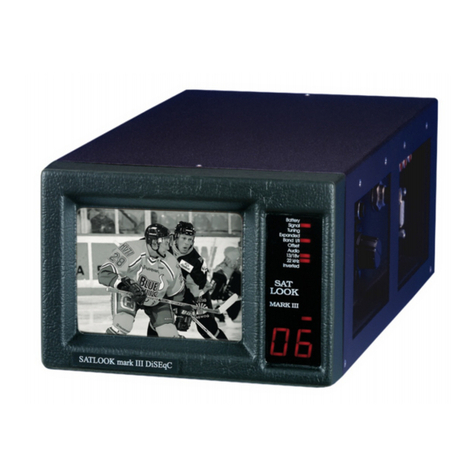
emitor
emitor SATLOOK Mark III DiSEqC manual
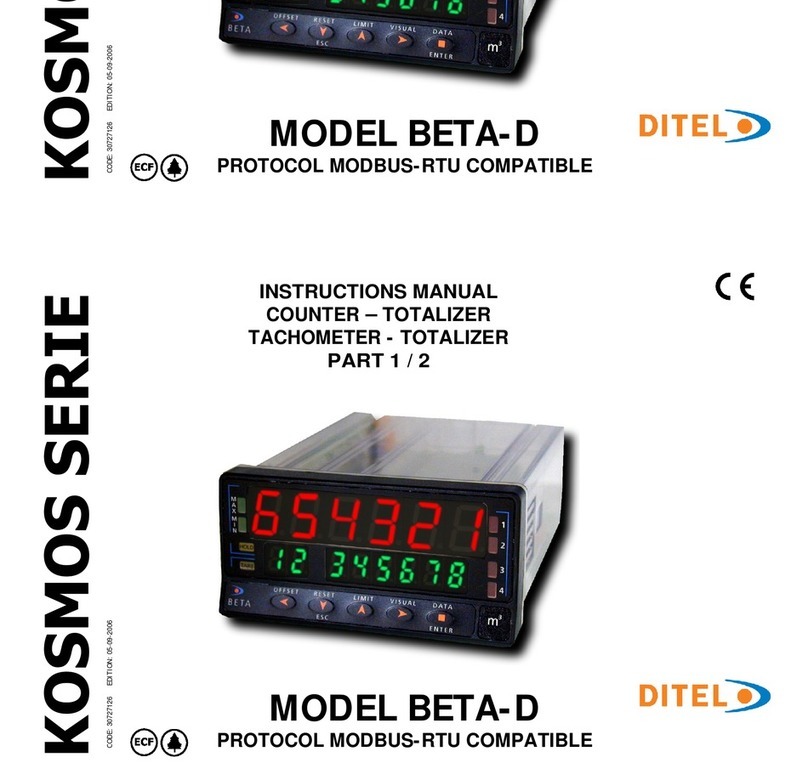
Ditel
Ditel BETA-D instruction manual
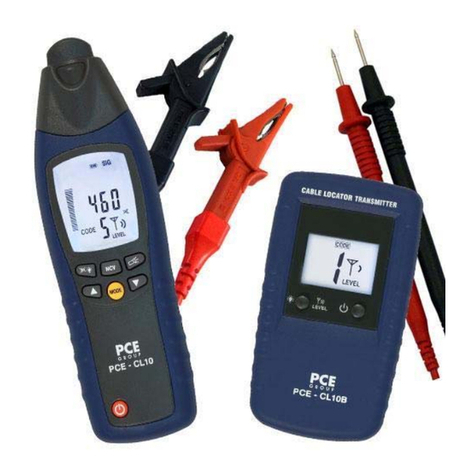
PCE Instruments
PCE Instruments PCE-CL 10 user manual
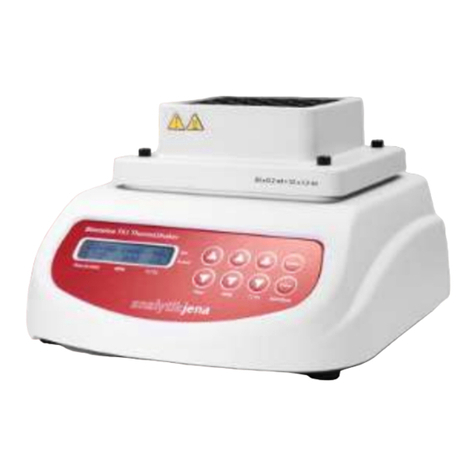
Endress+Hauser
Endress+Hauser Analytik Jena Biometra TS1 ThermoShaker Short manual

bredent
bredent HELBO TheraLite user manual

PAT
PAT DS 350 / 1334 GRAPHIC Operator's manual
